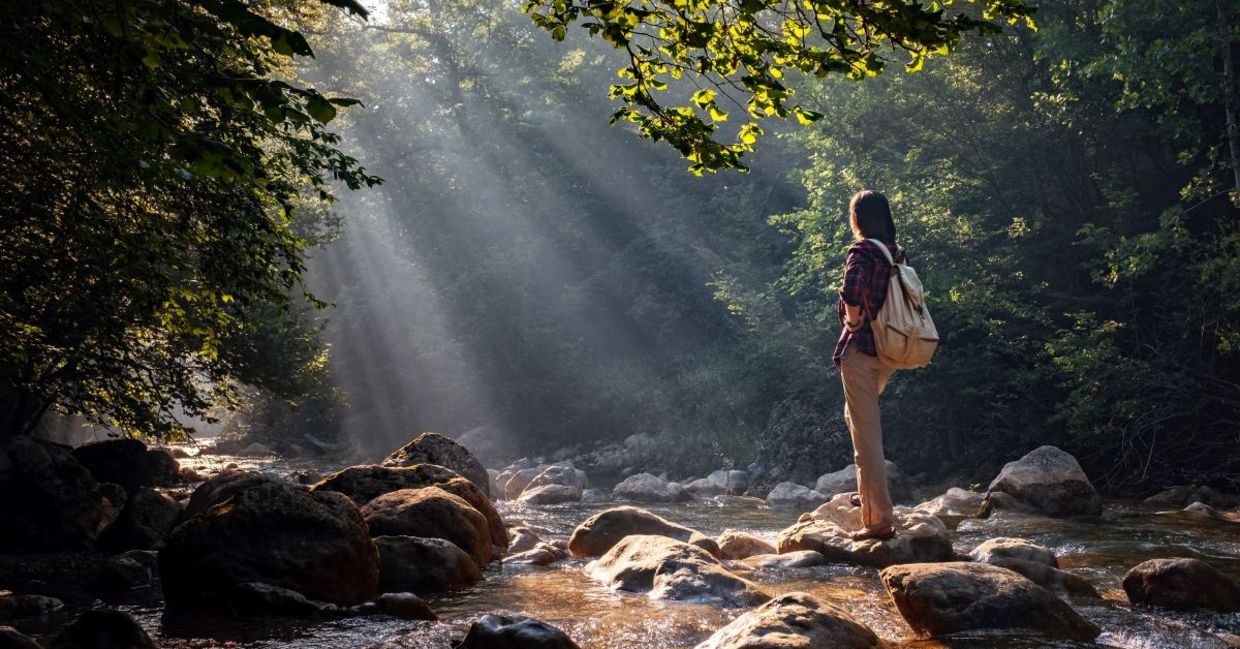
(U__Photo / Shutterstock.com)
Life has a way of pulling people in many directions, but nature always calls you back to stillness. In the quiet serenity of nature, you can find reflection, grace, and gratitude. Stepping into the world beyond your front door is an opportunity to tune out the distracting noise and focus on self-growth and self-reflection.
More and more people are recognizing the value of reflection walks in the great outdoors. These walks, accordig to the Healing Forest, could improve mood, boost relationships, as well as promote calmness and focus. Walking in nature may even positively impact physical health and improve your sleep.
Forest Bathing
Reflection walks source back to a 1980’s Japanese healing and meditative trend called shinrin-yoku, or forest bathing, the National Geographic reports. The movement encouraged people to take long, reflective walks in Japan’s ancient, tranquil forests.
It also sparked a wave of research studies about exploring the health benefits of forest bathing and spending time in nature. Researchers found that spending at least 120 minutes a week in nature is associated with an improvement in physical and mental health.
Today, more than four decades after the inception of the trend, forest bathing is still quite popular. People can even sign up for tours where a guide facilitates meditation within nature.
The Grace Trail
The Grace Trail is an example of self-guided reflection walk that was established by Plymouth, Massachusetts resident, Anna Jolles, reports WGBH News. Jolle started reflection walking during a low point in her life when she was overcome with worry about her son fighting abroad.
Jolles realized that she needed what she called grace, an acronym for gratitude, release, accept, challenge, and embrace, and that reflection walks in nature could facilitate these positive qualities. After reading about the Appalachian Trail, and how war vets used it to cope with memories, Jolles decided to create her own trail.
“I went down to the beach here in Plymouth, Massachusetts,” Jolles told WGBH. “I picked up the biggest rocks I could carry, and I wrote, ‘Gratitude. What are you grateful for?’
I did all five words on five large beach stones, and I put them along a harborside path in Plymouth, put up a map — and fully expected a cease and desist, which never came.”
Instead of removing the unauthorized trail, Plymouth embraced it. They called it the Plymouth Seaside Grace Trail and erected large boulders with Jolle’s quotes, in place of her small stones. It also inspired copycat trails, with 10 other grace trails opening across the country.
Contemplating on the power of reflection walks, Jolle shared that she meets all sorts of people on her trail, from grieving individuals looking for solace to couples on their wedding day, hoping to connect together.
How to do a Reflection Walk
During a reflection walk, participants walk deep into nature and meditate on gratitude, positivity, kindness, and creativity. Such an experience combines the healing power of nature, connection, and mindfulness.
The Healing Forest elaborates on how reflection walks work. All you need to get started is a pen and a notebook. Take it to a calm space and sit and think there. Reflect on the core emotions that make happiness grow including compassion, awe, gratitude, and creativity. Then, write for 10 minutes, recording your thoughts in a reflection journal.
You can ponder some of these prompts that are designed to foster the core positive emotions like: What are you grateful for? Who has inspired you? What acts of kindness did you do? Or, What do you want to create?
Reflection walks can be done solo but often going with a family member or close confidant can enhance the reflection experience. If you are with a companion, you can share your reflection. Even if you walk alone, you can connect remotely over a video app to share your thoughts with friends and family that are not in your immediate presence. After sharing, continue to walk for at least 10 more minutes.
Reflection walks demonstrate that you don’t need fancy gear to embrace the benefits of mindfulness, nature, and peace. All it takes is a notepad, a pencil, an open mind, and a few quiet steps to get started.
YOU MIGHT ALSO LIKE:
The Transformative Power of Self-Reflection
Taking an Awe Walk Can Make You Happier!
Healing Among the Trees: The Science and Serenity of Forest Therapy







